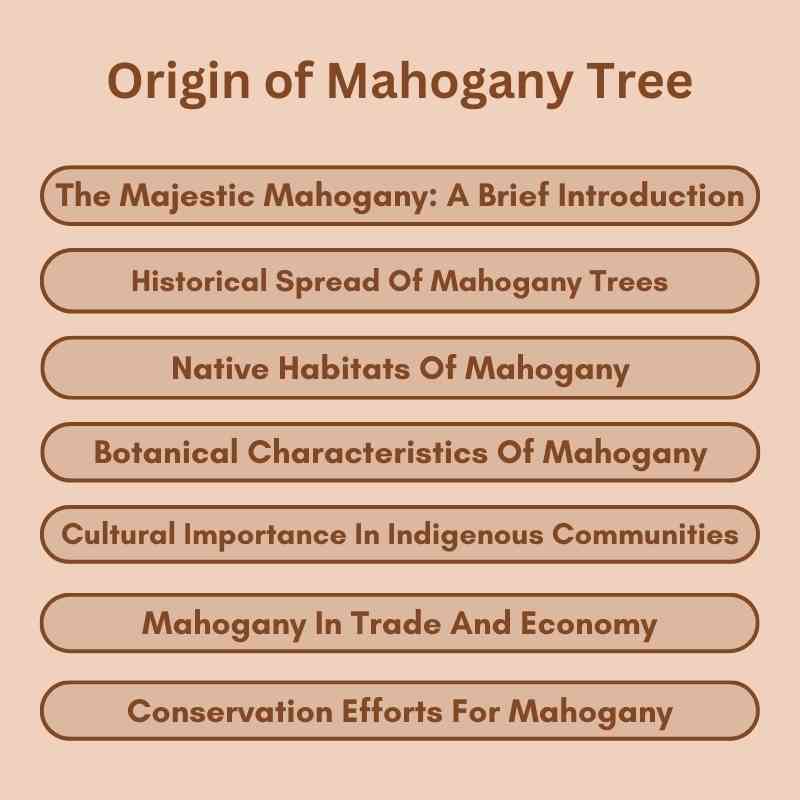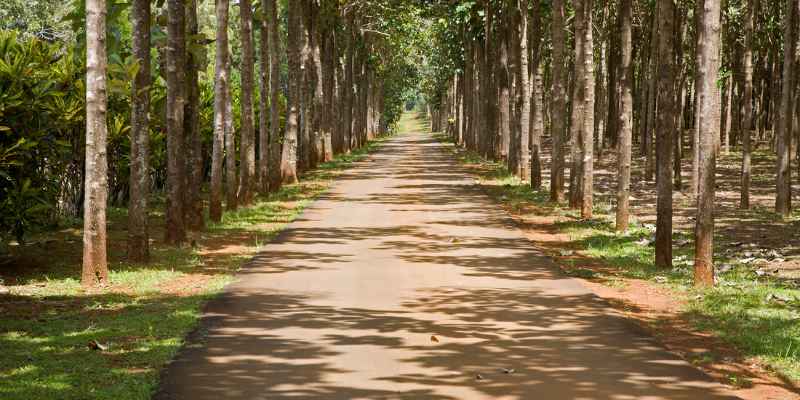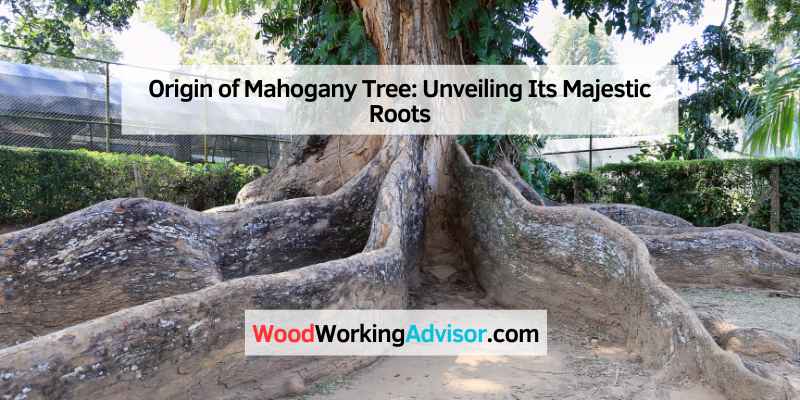The Mahogany tree originates from the tropical regions of the Americas, particularly Central America and the Caribbean. It thrives in diverse environments, including rainforests and coastal areas.
Mahogany trees belong to the Swietenia genus, known for their rich, reddish-brown wood. This wood is prized for its beauty and durability, making it a popular choice in furniture and cabinetry. Mahogany has been valued for centuries, often symbolizing luxury and quality.
The trees can grow up to 150 feet tall, featuring broad leaves and fragrant flowers. Over time, unsustainable harvesting practices have threatened Mahogany populations, leading to increased conservation efforts. Understanding the origins and significance of this tree is crucial for preserving its legacy and ensuring sustainable use for future generations.
The Majestic Mahogany: A Brief Introduction
The Mahogany tree is a symbol of strength and beauty. Its rich, reddish-brown wood is highly prized. This tree grows tall and sturdy in tropical regions. Mahogany has a long history, used in furniture and boats. Understanding its origin adds to its allure.
Symbolism And Significance
Mahogany holds deep meanings in various cultures. Its durability signifies strength and stability. Many view it as a symbol of wealth and luxury. Here are some key aspects:
- Beauty: Mahogany’s color and grain are striking.
- Durability: It withstands wear and tear.
- Tradition: Often used in handcrafted items.
In art, Mahogany represents creativity and craftsmanship. Its presence enhances any space, making it treasured worldwide.
Current Global Presence
Today, Mahogany trees grow in many parts of the world. Here are the key regions:
| Region | Country |
|---|---|
| Tropical America | Brazil, Mexico |
| Caribbean | Cuba, Jamaica |
| Africa | Cameroon, Ghana |
Mahogany is now endangered in some areas. Overharvesting threatens its survival. Conservation efforts are vital to protect this majestic tree.

Historical Spread Of Mahogany Trees
The historical spread of mahogany trees is fascinating. These trees, known for their beauty and durability, have a rich history. They have traveled across continents and found homes in various countries. Understanding their journey reveals much about trade and ecology.
Early Records And References
Mahogany trees have been part of human history for centuries. Early records show their significance in many cultures.
- The Mayan civilization used mahogany for building and art.
- Spanish explorers noted its presence in the Caribbean in the 16th century.
- British shipbuilders valued mahogany for ship construction in the 17th century.
Writings from the 18th century describe mahogany as a sought-after wood. Craftsmen admired its rich color and workability.
Expansion During Colonial Times
The colonial era marked a significant expansion of mahogany trees. European powers sought this valuable resource for trade.
| Region | Purpose |
|---|---|
| Caribbean | Furniture and shipbuilding |
| Central America | Construction and carvings |
| South America | Exports to Europe |
Trade routes developed to transport mahogany. Ships carried this wood to Europe and North America. Demand grew rapidly, leading to overharvesting. This affected mahogany populations in many areas.
Colonial policies also influenced mahogany’s spread. The British, Spanish, and French sought to control mahogany resources. This competition shaped the economic landscape of the time.
Native Habitats Of Mahogany
The Mahogany tree thrives in specific native habitats. It prefers warm, tropical climates. Understanding these areas helps appreciate its growth and significance.
Central And South American Origins
Mahogany trees mainly originate from Central and South America. They flourish in countries like:
- Mexico
- Guatemala
- Honduras
- Brazil
- Colombia
This region features:
| Climate | Characteristics |
|---|---|
| Tropical | Warm temperatures year-round |
| Humidity | High moisture levels support growth |
| Soil | Rich, well-drained soils |
These factors promote healthy Mahogany growth. They contribute to the tree’s strength and beauty.
Caribbean Growth
The Caribbean is another key habitat for Mahogany. Islands like:
- Jamaica
- Cuba
- The Bahamas
Here, Mahogany thrives in:
- Coastal areas
- Lowland rainforests
- Swampy regions
These locations provide essential nutrients and moisture. This helps Mahogany trees reach impressive heights and widths.
In the Caribbean, Mahogany plays a vital role in the ecosystem. It supports various wildlife and helps maintain forest health.
Botanical Characteristics Of Mahogany
The Mahogany tree is famous for its beauty and strength. Understanding its botanical characteristics helps appreciate its value. This section focuses on its species classification and unique traits.
Species Classification
Mahogany belongs to the family Swietenia. Several species exist, each with distinct features. The most notable species include:
| Species Name | Common Name | Native Region |
|---|---|---|
| Swietenia macrophylla | Honduran Mahogany | Central America |
| Swietenia mahagoni | American Mahogany | Caribbean |
| Swietenia humilis | Pacific Coast Mahogany | South America |
Unique Traits And Features
Mahogany trees are known for their robust qualities. Here are some unique traits:
- Height: Can grow up to 150 feet tall.
- Diameter: Can reach over 4 feet in width.
- Leaves: Large, glossy, and compound leaves.
- Bark: Thick, reddish-brown bark that is rough.
The wood is prized for its rich color and durability. It ranges from reddish-brown to dark brown. Its fine grain makes it easy to work with.
Mahogany trees also produce small, fragrant flowers. These flowers are white to yellow and grow in clusters. The fruits are dehiscent capsules, which split open to release seeds.
Cultural Importance In Indigenous Communities
The Mahogany tree holds significant cultural value for many indigenous communities. Its wood is not just prized for its beauty but also for its uses in traditional practices. These communities have deep connections to the Mahogany, shaping their identity and cultural heritage.
Traditional Uses
Indigenous communities utilize Mahogany in various ways. Here are some common uses:
- Building materials: Mahogany is used in homes and community structures.
- Crafts: Artisans create intricate carvings and furniture.
- Musical instruments: Mahogany is often used to make drums and other instruments.
- Medicinal purposes: Parts of the tree may be used for healing remedies.
These uses reflect the tree’s importance in daily life and cultural practices. The durability and beauty of Mahogany make it a favorite for both practical and artistic applications.
Spiritual Connections
The Mahogany tree is more than a resource. It symbolizes strength and resilience in many cultures. Here are key aspects of its spiritual significance:
- Connection to ancestors: The tree is often seen as a link to the past.
- Rituals: Mahogany may be used in ceremonies and offerings.
- Protection: Some believe it provides spiritual safeguarding.
These beliefs enhance the Mahogany’s role in cultural traditions. The tree is revered, showcasing respect for nature and heritage.
Mahogany In Trade And Economy
The mahogany tree is highly valued in trade. Its rich color and durability make it popular for furniture and construction. The mahogany market has a significant impact on local economies.
The Boom Of The Mahogany Market
In the 18th and 19th centuries, mahogany became a luxury item. Demand soared in Europe and North America. This led to extensive logging in tropical forests.
- High-quality mahogany often fetched high prices.
- Skilled artisans crafted exquisite furniture from mahogany.
- Many countries relied on mahogany exports for revenue.
The mahogany market created jobs in logging and craftsmanship. Many communities thrived from this trade. However, overharvesting led to environmental concerns.
Effects On Local Economies
Mahogany trade has both positive and negative effects on local economies. Here are the key impacts:
| Impact | Positive Effects | Negative Effects |
|---|---|---|
| Job Creation | Increased employment in logging and crafting. | Risk of job loss due to overlogging. |
| Economic Growth | Boost in local businesses and trade. | Dependence on a single resource for income. |
| Infrastructure Development | Improved roads and facilities for transport. | Environmental degradation affecting communities. |
Communities that rely on mahogany need sustainable practices. Balancing economic growth and environmental health is crucial.
Conservation Efforts For Mahogany
The mahogany tree is a symbol of beauty and value. Its rich wood is highly sought after. This demand has led to serious threats to its survival. Conservation efforts are vital for protecting this majestic tree. Let’s explore the current efforts in place to save mahogany.
Endangered Status And Regulations
Mahogany trees face an endangered status due to overharvesting. Here are some key points about its status:
- International Trade: Mahogany is listed under CITES.
- Protection Laws: Many countries have strict laws.
- Illegal Logging: This remains a major threat.
Regulations aim to control the trade and protect forests. Governments are working together to enforce these laws.
Sustainable Sourcing Initiatives
Sustainable sourcing is crucial for mahogany’s future. Various initiatives are in place, including:
- Certification Programs: These ensure wood is sourced legally.
- Reforestation Projects: New trees are planted to replace cut ones.
- Community Involvement: Local communities participate in conservation.
These initiatives help balance economic needs with environmental protection. They promote responsible management of mahogany resources.
| Initiative | Description | Benefits |
|---|---|---|
| Certification Programs | Verify sustainable wood sourcing. | Supports legal trade. |
| Reforestation Projects | Plant new mahogany trees. | Restores habitats. |
| Community Involvement | Engage locals in conservation. | Empowers communities. |
These efforts play a significant role in ensuring the future of mahogany trees. Protecting this tree helps maintain biodiversity and forest health.
The Future Of Mahogany Trees
The future of mahogany trees holds promise and challenges. These trees are valued for their beauty and strength. Protecting them is essential for many ecosystems. Understanding future trends helps in sustainable management.
Scientific Research And Breeding
Scientists focus on research to improve mahogany tree resilience. They study various genetic traits for better growth and disease resistance. Here are some key areas of focus:
- Genetic Diversity: Maintaining diverse gene pools is crucial.
- Hybrid Varieties: Breeding hybrids can enhance growth rates.
- Clonal Propagation: Using clones can ensure consistent quality.
Research programs also aim to develop faster-growing trees. These programs help meet the growing demand for mahogany timber.
Impact Of Climate Change
Climate change poses a significant threat to mahogany trees. Rising temperatures affect their growth and health. Here are some impacts of climate change:
| Impact | Description |
|---|---|
| Temperature Changes | Higher temperatures can stress trees, reducing growth. |
| Altered Rainfall Patterns | Irregular rainfall can lead to drought or flooding. |
| Pest and Disease Spread | Warmer climates may increase pest populations. |
Conservation efforts focus on planting trees in suitable areas. Sustainable forestry practices help mitigate these effects. Protecting mahogany trees is vital for our planet’s health.

Frequently Asked Questions
What Is The Origin Of The Mahogany Tree?
The Mahogany tree, scientifically known as Swietenia, originates from the tropical regions of the Americas. It is primarily found in countries like Honduras, Belize, and parts of the Caribbean. The tree thrives in rich, well-drained soils, contributing to its high-quality timber.
Where Are Mahogany Trees Primarily Found?
Mahogany trees are predominantly located in Central and South America. They flourish in tropical rainforests, particularly in countries such as Honduras and Brazil. These regions provide the warm climate and moisture necessary for the tree’s growth.
How Long Do Mahogany Trees Live?
Mahogany trees can live for over 100 years under optimal conditions. Their longevity makes them a sustainable choice for timber production. However, factors like deforestation and climate change can impact their lifespan in the wild.
What Are The Uses Of Mahogany Wood?
Mahogany wood is highly sought after for its durability and aesthetic appeal. It is commonly used in furniture, cabinetry, and musical instruments. Its rich color and fine grain also make it a favorite for high-end woodworking projects.
Conclusion
The Mahogany tree has a rich history that spans centuries. Its origins trace back to the tropical regions of Central and South America. This majestic tree is valued for its beauty and durability. Understanding its background highlights the importance of conservation efforts for this incredible species.
Protecting Mahogany ensures its legacy for future generations.

